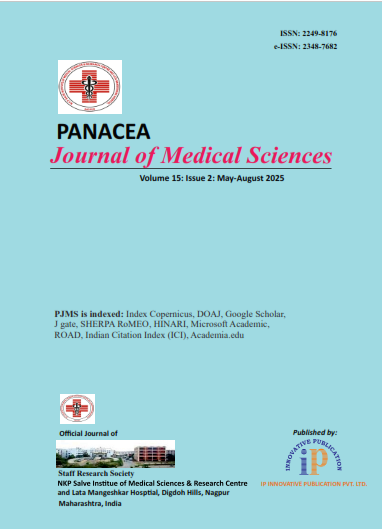Panacea Journal of Medical Sciences
Panacea Journal of Medical Sciences (PJMS) open access, peer-reviewed triannually journal publishing since 2011 and is published under auspices of the “NKP Salve Institute of Medical Sciences and Research Centre”. With the aim of faster and better dissemination of knowledge, we will be publishing the article ‘Ahead of Print’ immediately on acceptance. In addition, the journal would allow free access (Open Access) to its contents, which is likely to attract more readers and citations to articles published in PJMS.Manuscripts must be prepared in accordance with “Uniform requiremen...

Prevalence of nasal carriage of methicillin resistant Staphylococcus aureus among health care workers in a teaching hospital in Eastern India
Page: 298-303
Introduction: Methicillin-resistant Staphylococcus aureus (MRSA) is a strain of antibiotic-resistant Staphylococcus aureus that has acquired resistance to beta-lactam antibiotics. The emergence of MRSA has significantly enhanced the morbidity and mortality of infected people. It has threatened healthcare facilities in many countries, including India. Healthcare workers can colonize the bacteria and serve as reservoirs of infection. Therefore, it is important to evaluate the problem of MRSA colonization in HCWs to develop preventive measures.
Aim and Objective: This study aimed to determine the prevalence of nasal colonization with S. aureus and MRSA among the HCWs and test antibiotic susceptibility.
Materials and Methods: It was a prospective observational study. Nasal swabs were taken from 190 ICU workers as per the study protocol. The swabs were inoculated in Mannitol Sugar Agar (MSA). MRSA were detected according to CLSI guidelines followed by antibiotic susceptibility testing.
Results: Among 190 samples from HCWs, 19 were detected to be MRSA carriers. The carriage rate is the highest in House-Keeping staff. Female (10.31%) have a slightly higher propensity to carry MRSA than male (9.37%). All MRSA in this study were sensitive to Bacitracin and Linezolid followed by Mupirocin (89.4%) and Minocycline (84.21%). All the MRSA were resistant to Penicillin followed by Erythromycin (73.68%), Ciprofloxacin (63.15%), Co-trimoxazole (57.8%), and Amikacin (47.36%).
Conclusion: MRSA colonization in HCWs may serve as a source of infection both in community as well as in hospitals. Utmost maintenance of hygiene, aseptic measures and judicious use of antibiotics are of paramount importance to prevent morbidity and mortality from this potential threat.
Article Metrics
- Visibility 16 Views
- Downloads 5 Views
- DOI 10.18231/pjms.v.15.i.2.298-303
-
CrossMark
- Citation
- Received Date May 20, 2025
- Accepted Date June 18, 2025
- Publication Date August 19, 2025